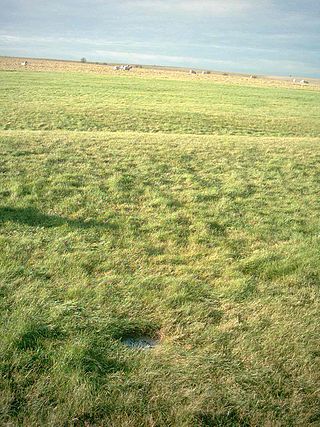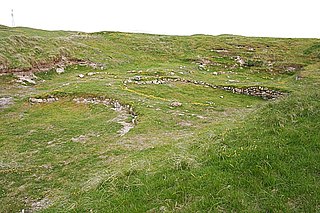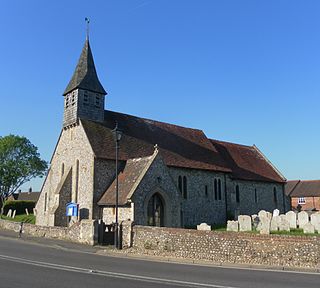Related Research Articles

Stonehenge is a prehistoric megalithic structure on Salisbury Plain in Wiltshire, England, two miles (3 km) west of Amesbury. It consists of an outer ring of vertical sarsen standing stones, each around 13 feet (4.0 m) high, seven feet (2.1 m) wide, and weighing around 25 tons, topped by connecting horizontal lintel stones. Inside is a ring of smaller bluestones. Inside these are free-standing trilithons, two bulkier vertical sarsens joined by one lintel. The whole monument, now ruinous, is aligned towards the sunrise on the summer solstice and sunset on the winter solstice. The stones are set within earthworks in the middle of the densest complex of Neolithic and Bronze Age monuments in England, including several hundred tumuli.

The foot is a unit of length in the British imperial and United States customary systems of measurement. The prime symbol, ′, is commonly used to represent the foot. In both customary and imperial units, one foot comprises 12 inches, and one yard comprises three feet. Since an international agreement in 1959, the foot is defined as equal to exactly 0.3048 meters.

Avebury is a Neolithic henge monument containing three stone circles, around the village of Avebury in Wiltshire, in southwest England. One of the best known prehistoric sites in Britain, it contains the largest megalithic stone circle in the world. It is both a tourist attraction and a place of religious importance to contemporary pagans.

Durrington Walls is the site of a large Neolithic settlement and later henge enclosure located in the Stonehenge World Heritage Site in England. It lies 2 miles (3.2 km) north-east of Stonehenge in the parish of Durrington, just north of Amesbury in Wiltshire. The henge is the second-largest Late Neolithic palisaded enclosure known in the United Kingdom, after Hindwell in Wales.

The Aubrey holes are a ring of 56 chalk pits at Stonehenge, named after seventeenth-century antiquarian John Aubrey. They date to the earliest phases of Stonehenge in the late fourth and early third millennium BC. Despite decades of argument and analysis, their purpose is still unknown, although an astronomical role has often been suggested.

Cladh Hallan is an archaeological site on the island of South Uist in the Outer Hebrides in Scotland. It is significant as the only place in Great Britain where prehistoric mummies have been found. Excavations were carried out there between 1988 and 2002, which indicate the site was occupied from 2000 BC.
Michael Parker Pearson, is an English archaeologist specialising in the study of the Neolithic British Isles, Madagascar and the archaeology of death and burial. A professor at the UCL Institute of Archaeology, he previously worked for 25 years as a professor at the University of Sheffield in England, and was the director of the Stonehenge Riverside Project. A prolific author, he has also written a variety of books on the subject.

Swinside, which is also known as Sunkenkirk and Swineshead, is a stone circle lying beside Swinside Fell, part of Black Combe in southern Cumbria, North West England. One of around 1,300 recorded stone circles in the British Isles and Brittany, it was constructed as a part of a megalithic tradition that lasted from 3,300 to 900 BC, during what archaeologists categorise as the Late Neolithic and Early Bronze Ages.

Lavant is a civil parish in the Chichester district of West Sussex, England, 2.2 miles (3.5 km) north of Chichester. It includes three villages: Mid Lavant and East Lavant, which are separate Anglican parishes, and the much smaller West Lavant. It takes its name from the River Lavant which flows from East Dean to Chichester.

Stonehenge has been the subject of many theories about its origin, ranging from the academic worlds of archaeology to explanations from mythology and the paranormal.

Carved stone balls are petrospheres dated from the late Neolithic, to possibly as late as the Iron Age, mainly found in Scotland, but also elsewhere in Britain and Ireland. They are usually round and rarely oval, and of fairly uniform size at around 2+3⁄4 inches or 7 cm across, with anything between 3 and 160 protruding knobs on the surface. They range from having no ornamentation to extensive and highly varied engraved patterns. A wide range of theories has been produced to explain their use or significance, with none gaining very wide acceptance.

Bush Barrow is a site of the early British Bronze Age Wessex culture, at the western end of the Normanton Down Barrows cemetery in Wiltshire, England. It is among the most important sites of the Stonehenge complex, having produced some of the most spectacular grave goods in Britain. It was excavated in 1808 by William Cunnington for Sir Richard Colt Hoare. The finds, including worked gold objects, are displayed at Wiltshire Museum in Devizes.
The Stonehenge Riverside Project was a major Arts and Humanities Research Council-funded archaeological research study of the development of the Stonehenge landscape in Neolithic and Bronze Age Britain. In particular, the project examined the relationship between the Stones and surrounding monuments and features, including the River Avon, Durrington Walls, the Cursus, the Avenue, Woodhenge, burial mounds, and nearby standing stones. The project involved a substantial amount of fieldwork and ran from 2003 to 2009. It found that Stonehenge was built 500 years earlier than previously thought. The monument is believed to have been built to unify the peoples of Britain. It also found a previously unknown stone circle, Bluestonehenge.

Bluestonehenge or Bluehenge is a prehistoric henge and stone circle monument that was discovered by the Stonehenge Riverside Project about 1 mile (1.6 km) south-east of Stonehenge in Wiltshire, England. All that remains of the site is the ditch of the henge and a series of stone settings, none of which is visible above ground.
Timothy Darvill OBE is an English archaeologist and author, best known for his publications on prehistoric Britain and his excavations in England, Wales, and the Isle of Man. He is Professor of Archaeology in the Faculty of Science and Technology Bournemouth University in England. In April 2008 he co-directed excavations within Stonehenge, together with Professor Geoffrey Wainwright and Dr Miles Russell, to examine the early stone structures on the site. The work featured heavily in a BBC Timewatch programme which examined the theory that Stonehenge was a prehistoric centre of healing. He was appointed OBE in the 2010 Queen's Birthday Honours.

The Neolithic period in the British Isles lasted from c. 4100 to c. 2,500 BC. Constituting the final stage of the Stone Age in the region, it was preceded by the Mesolithic and followed by the Bronze Age.

The stone circles in the British Isles and Brittany are a megalithic tradition of monuments consisting of standing stones arranged in rings. These were constructed from 3300 to 900 BCE in Britain, Ireland and Brittany. It has been estimated that around 4,000 of these monuments were originally constructed in this part of north-western Europe during this period. Around 1,300 of them are recorded, the others having been destroyed.

The Folkton Drums are a very rare set of three decorated chalk objects in the shape of drums or solid cylinders dating from the Neolithic period. Found in a child's grave near the village of Folkton in northern England, they are now on loan to Stonehenge Visitor Centre from the British Museum. A similar object, the Burton Agnes drum was found 15 miles away near Burton Agnes in 2015, and another example, the Lavant drum, was excavated in 1993 in Lavant, West Sussex.

Waun Mawn is the site of a possible dismantled Neolithic stone circle in the Preseli Mountains of Pembrokeshire, Wales. The diameter of the postulated circle is estimated to be 110 m (360 ft), the third largest diameter for a British stone circle.

The Burton Agnes drum is a carved chalk cylinder dated from 3005 to 2890 BC which was found in 2015 near Burton Agnes, East Riding of Yorkshire, England. The British Museum has described it as "the most important piece of prehistoric art to be found in Britain in the last 100 years" and "one of the most significant ancient objects ever found on the British Isles". It was found in the grave of three children, along with a chalk ball and a bone pin.
References
- ↑ "The Novium - Lavant Drum - Measuring Device from the Time of Stonehenge". www.thenovium.org. Retrieved 9 December 2019.
- ↑ Thomas, Tobi (10 February 2022). "Ancient sculpture is 'most important prehistoric art find in UK for century'". The Guardian. Retrieved 11 February 2022.
- 1 2 Kenny, James; Teather, Anne M. (2016). "New insights into the Neolithic chalk drums from Folkton (North Yorkshire) and Lavant (West Sussex)". PAST: The Newsletter of the Prehistoric Society. 83: 5–6.
- 1 2 Jones, Andrew Meirion; Cochrane, Andrew; Carter, Chris; Dawson, Ian; Díaz-Guardamino, Marta; Kotoula, Eleni; Minkin, Louisa (2015). "Digital imaging and prehistoric imagery: a new analysis of the Folkton Drums". Antiquity. 89 (347): 1085. doi:10.15184/aqy.2015.127. ISSN 0003-598X. S2CID 128522875.
- ↑ Teather, Anne; Chamberlain, Andrew; Parker Pearson, Mike (2 January 2019). "The chalk drums from Folkton and Lavant: Measuring devices from the time of Stonehenge". British Journal for the History of Mathematics. 34 (1): 1–11. doi: 10.1080/17498430.2018.1555927 . ISSN 2637-5451.
- ↑ Teather, Anne; Chamberlain, Andrew; Parker Pearson, Mike (2 January 2019). "The chalk drums from Folkton and Lavant: Measuring devices from the time of Stonehenge". British Journal for the History of Mathematics. 34 (1): 4. doi: 10.1080/17498430.2018.1555927 . ISSN 2637-5451.
- ↑ Chamberlain, Andrew; Parker Pearson, Michael (2007). "Units of measurement in Late Neolithic southern Britain". In Larsson, Mats; Parker Pearson, Michael (eds.). From Stonehenge to the Baltic: Living with cultural diversity in the third millennium BC. Oxford: Archaeopress. pp. 169–174.
- ↑ Teather, Anne; Chamberlain, Andrew; Parker Pearson, Mike (2 January 2019). "The chalk drums from Folkton and Lavant: Measuring devices from the time of Stonehenge". British Journal for the History of Mathematics. 34 (1): 7. doi: 10.1080/17498430.2018.1555927 . ISSN 2637-5451.